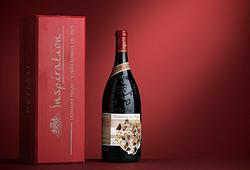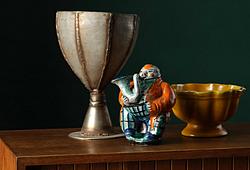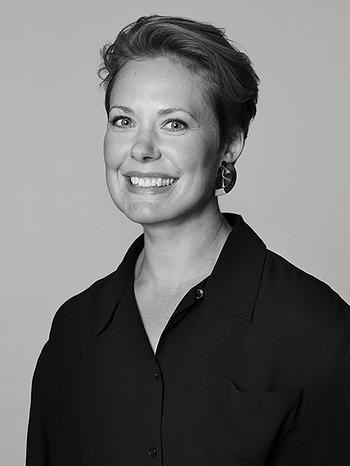Öyvind Fahlström
"ADE-LEDIC-NANDER I"
Executed in 1955. Oil, lacquer and tempera on masonite 65 x 54 cm.
Alkuperä - Provenienssi
Roberto Matta, Rom.
Robert Rauschenberg, New York.
Robert Rauschenberg Foundation, New York.
Sotheby's, Contemporary Art, New York, 15 May 2013.
Private Collection, Sweden.
Bukowski Auktioner AB, Contemporary Art & Design 576, 14 November 2013, Cat. No. 407.
Private Collection.
Näyttelyt
Galerie Aesthetica, Stockholm, ”Öyvind Fahlström”, 31 August - 15 September 1955.
Galerie Daniel Cordier, Paris, ”Öyvind Fahlström”, 19 February - 15 March 1959.
Galerie Blanche, Stockholm, ”Öyvind Fahlström”, 4 - 18 April 1959.
Travelling exhibition curated by Museum of Modern Art, New York, "Öyvind Fahlström", exhibited at:
University of Minnesota, Minneapolis, 17 April - 11 May 1969.
Middlebury College Museum of Art, 3 - 26 October 1969.
Edinboro State College, 17 November - 8 December 1969.
University of Georgia Museum of Art, Athens, 7 January - 1 February 1970.
University of Texas, Blanton Museum of Art, Austin, 8 - 23 March 1970.
Sacramento State College, 20 April - 11 May 1970.
Städtische Galerie im Lenbachhaus, München, “Let’s Mix All Feelings Together”, 20 March - 4 May 1975.
The exhibition travelled to:
Kunstverein, Frankfurt am Main, 20 June - 10 August 1975.
Musèe d’art moderne de la ville de Paris, 18 December - 19 January 1976.
Louisiana Museum, Humlebaeck, 13 March - 25 April 1976.
Moderna Museet, Stockholm, ”Öyvind Fahlström”, 13 October - 9 December 1979.
Centre Georges Pompidou, Paris, ”Öyvind Fahlström”, 23 January - 31 March 1980.
Museum Boymans van Beuningen, Rotterdam, "Fahlström", 10 May - 15 June 1980.
Solomon R. Guggenheim Museum, New York, "Öyvind Fahlström", 13 September - 7 November 1982.
Walker Art Center, Minneapolis, “Öyvind Fahlström: Paintings, Drawings, Constructions”, 4 February – 27 March 1983.
IVAM/Centro Julio González, Valencia, "Öyvind Fahlström", 10 June - 23 August 1992.
Museu d’Art Contemporani de Barcelona (MACBA), “Öyvind Fahlström – Another Space for Painting”, 17 October 2000 - 8 January 2001. The exhibition travelled to:
Centro Studi sull’arte Fondazione Ragghianti – Complesso monumentale de San Micheleletto, Lucca, 18 March – 15 May 2001.
Massachussetts Museum of Contemporary Art, North Adams, June – November 2001.
Institut d’art contemporain, Lyon, 15 February – 26 May 2002.
Baltic Centre for Contemporary Art, Gateshead, 27 September - 24 November 2002.
Mjellby Konstmuseum, ”Öyvind Fahlström – Med världen som spelplan”, 3 June - 16 September 2007.
Moderna Museet, Stockholm, "Ade-Ledic-Nander", 22 April - November 2017.
Kirjallisuus
Bonniers små konstböcker, ”Öyvind Fahlström”, 1967, illustrated.
Björn Springfeldt (ed.), "Öyvind Fahlström", Moderna Museet, Stockholm, exhibition catalogue no 164, 1979, illustrated p. 20.
Teddy Hultberg, ”Öyvind Fahlström i etern – Manipulera världen”, 1999, illustrated.
Jean-Francois Chevrier et al., "Fahlström - Another Space for Painting", 2000, illustrated full page in colour p. 71.
Sophie Allgårdh (ed.), "Öyvind Fahlström - med världen som spelplan”, 2007, illustrated p. 28.
Jesper Olsson, Fredrik Liew (ed.), "Ade-Ledic-Nander", Moderna museet, Stockholm, 2017, illustrated p. 3, 29, 30, 32, 45, 51, 72.
Muut tiedot
During the first half of the 1950s Öyvind Fahlström had mainly focused on being a writer, but because he didn’t succeed in publishing anything (despite multiple attempts) he eventually put more effort into his art. His artistic production up until 1955 had predominantly consisted of ink drawings and experiments with painting on metal foil or glass. But, for his solo show at Galerie Aesthetica in Stockholm in the autumn of 1955 (which he had paid for himself), he made his first paintings, of which Ade-Ledic-Nander I was the very first.
In the pamphlet for the Aesthetica exhibition in 1955 Fahlström formulated for the first time a program for ‘signifigurativt teckenmåleri’ or ‘signifigurative painting as signs’. The term ‘signifiguration’ was a made-up term combining the French words ‘signe’ (sign), ‘signification’ (meaning) and ‘figuration’ (form, representation). Fahlström’s idea was to create complex non-figurative ‘sign shapes’ that would act somewhat like beings or organisms on the canvas, according to a set of pre-determined rules. The program can be seen as an attempt to resurrect storytelling within the framework of non-figurative art.
To create his sign shapes Fahlström used, for example, microscope photographs of plants and invertebrates, images of organs and tissues, colour polarisations, architectural plans, electrical circuit diagrams and cross-sectional studies of plane engines.
Ade-Ledic-Nander was the name of a giant project that Fahlström had planned in order to realise his ideas of signifigurative painting as signs. In twenty or so paintings he would tell the story of an imagined universe built by individuals and sign shapes from three different clans called ‘Ade’, ‘Ledic’ and ‘Nander’, which fought against one other. The project never truly got off the ground, and only the small introductory ‘no 1’ and the large ‘no 2’ were ever finished.
Fahlström had found the seemingly arbitrary title in a science fiction short story entitled Far Centaurus by A. E. Van Vogt (1944): “‘The adeledicnander force’. said Cassellahat. ‘I’ve already tried to explain it to Mr. Renfrew, but his mind seems to balk at some of the most simple aspects’.”
In preparation for the Ade-Ledic-Nander paintings Fahlström systematised a large number of rules, which he continued to use when the work was underway. One key concept was the mova – an acronym made up of the Swedish words ‘miljö’ (environment), ‘objekt’ (object), ‘varelse’ (being) and ‘aktion’ (action). The mova created separate cells (sign shapes) to which Fahlström attributed certain qualities or functions, which determined how they would act in the painting. In December 1957, following the completion of Ade-Ledic-Nander I and Ade-Ledic-Nander II, he wrote a twenty-seven page description of the images’ content. In the text he describes what was happening to the various movas acting on the canvas. The painting is a story that recounts a number of events in sequences (‘tidsfaser’ or ‘time-phases’) spread across the canvas. In Ade-Ledic-Nander I this involves eighteen different movas. The close-ups of the painting show how a mova appears in various places – transformed yet still fully recognisable.
Pontus Hultén has recounted how when working on Ade-Ledic-Nander Fahlström would sometimes invite his friends around to view the painting developing. He would use a very original demonstration technique which consisted of hanging a sheet, in which he had cut a small hole, in front of the painting. He would then describe in detail the section of the painting that was visible through the hole. This was done so as to not distract the viewer from other elements of the painting or from the image as a whole.
Hultén has here identified how a viewer might best ‘read’ an image such as Ade-Ledic-Nander I. You must take a step forward, study the various movas (the sign shapes) and their relationships, but not concern yourself with the whole. The painting is not a composition as such but an ‘arena’ for different chains of events.
There is no pictorial depth in Ade-Ledic-Nander I, everything happens on the surface – which is necessary in order to perceive the various movas. The colour palette is dry, almost cool, and against the pale yellow background the movas emerge in muted colours like brownish red, blue or greyish blue.
Fahlström’s signifigurative painting as signs was based on several invented rules and was therefore impossible to characterise within a more general visual language. If one did not know anything about Fahlström’s intentions, it would be easy to ‘read’ his images as compositions and not as chains of events and processes. Knowledge about Fahlström’s notions of sign shapes, rules and time-phases is required in order to really penetrate his visual universe. Like Duchamp’s ‘large glass’ La Mariée mise à nu par ses célibataires, même (1915-23) the Ade-Ledic-Nander paintings can never be completely understood without knowing about the theory that, although invisible, lies behind it.
The Ade-Ledic-Nander paintings are two key works in Fahlström’s early artistic production, in their consistent application of the ideas he had raised in the program for a signifigurative painting as signs. And even if the games paintings of the 1960s might at first glance seem far from the introverted and detailed worlds of signs of the 1950s, his fundamental ideas about signs, games and time have remained in those works too.
The ownership history of Ade-Ledic-Nander I is also interesting. The two first owners, Roberto Matta and Robert Rauschenberg, have both been very influential in Fahlström’s artistic practice, in different ways. Matta’s art inspired Fahlström’s notions of signifigurative painting as signs and Rauschenberg helped him get established in New York. Matta had bought Ade-Ledic-Nander I in 1959 at Fahlström’s Galerie Daniel Cordier exhibition in Paris. How it later ended up in Rauschenberg’s possession is unknown. What is clear is that Rauschenberg valued the painting highly – according to the Robert Rauschenberg Foundation archives it hanged in the bedroom of his New York apartment. Both Matta and Rauschenberg were close friends with Fahlström and their friendships lasted up until their final days.
This text is an extract from a longer piece written by Lars Hjelmstedt, an art historian specialising in Öyvind Fahlström.




























